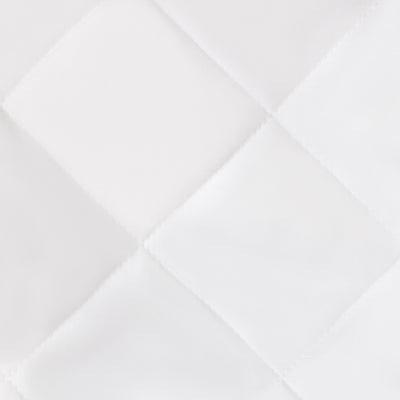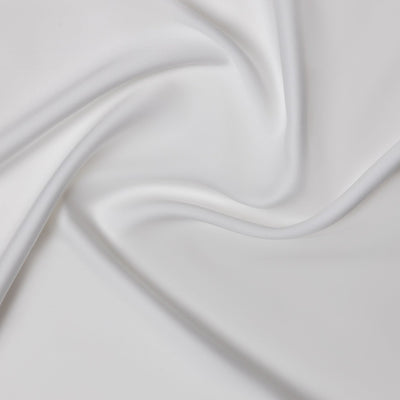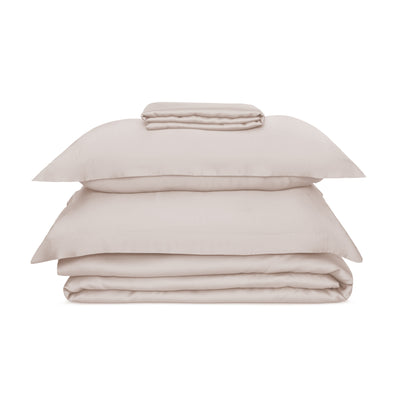Viscose is said to be the world’s third most commonly used textile fibre, but how much do we really know about it? The fibre that can be found in everything from our clothing to our curtains, is widely misunderstood and deserves recognition.
We’re here to clear up the misconceptions over this semi-synthetic invention to make fabric buying decisions simpler.
VISCOSE FABRIC KEY QUESTIONS AND INFORMATION
- Introducing Viscose Fabric
- What is Viscose Fabric?
- How is Viscose Fabric Made?
- Benefits of Viscose Fabric
- Problems with Viscose Fabric
- Uses of Viscose Fabric
- Viscose Fabric Care
- Is Viscose Fabric Sustainable?
- Alternatives to Viscose Fabric
INTRODUCING VISCOSE FABRIC
Is Viscose Natural?
Viscose rayon is a manufactured fibre that falls in between the categories of natural and artificial. The fibres of viscose rayon come from the natural source cellulose, a structural component of plant walls. However, the final product is man-made.
History of Viscose
Viscose fabric was first invented in the 19th century as a cheaper alternative to silk. However, it originally failed to gain popularity as the design was highly flammable. A few years later in 1892, the production of a less flammable Viscose was patented by British scientists Edward John Bevan and Charles Frederik Cross and was sold in the early 20th century.
Today, Viscose is widely used as an artificial silk for many homeware and bedding products.
WHAT IS VISCOSE FABRIC
Viscose is considered a regenerated cellulose fibre; the original wood cellulose fibres undergo chemical processes that break them down before they are once again reformed to be spun into yarn and then woven into viscose sheets.
Natural fibres such as cotton or silk don’t need much processing before being spun into yarn. On the other hand, rayon and other manmade fibres rely on several step processes for their transformation into usable yarn.
Viscose is a type of rayon and although the two are similar, they have notable differences. Rayon is made from cellulose fibres. The cellulose fibres can either come from wood, bamboo or other sources.
Rayon that is created from bamboo cellulose or other sources is known simply as rayon. Viscose rayon is made only from wood cellulose fibres and gets its name from the organic liquid viscose which is produced during the process of manufacture of viscose rayon.
HOW IS VISCOSE FABRIC MADE?
Rayon and viscose are manufactured using the same method but differ in the materials used. Rayon is made from the cellulose of a variety of plants whereas viscose is solely made from wood cellulose.
In the process of making viscose, wood cellulose must first be isolated from the wood. This is done by cutting the trees into small pieces, treating it with calcium bisulphate and steaming it under pressure.
The ‘glue’ that holds the wood together (lignon) is then washed away, thereby purifying the wood cellulose. Wood cellulose is bleached and converted into wood pulp which is cut to the appropriate size and kept moist at 30°C.
Sheets of wood pulp are left to soak is a solution of caustic soda. The wet sheets are shredded into crumbs which are left for 48 hours to age.
The crumbs of wood pulp are treated with carbon disulphide and mixed slowly. This eventually creates sodium cellulose xanthate, which is dissolved into the thick, clear brown liquid that is known as viscose.
The viscose solution is ripened over 5 days before being pushed through the fine holes of a spinneret to form the regenerated cellulose fibres.
The fibres are wound onto a spindle, spun into yarns and then woven into viscose fabric.
BENEFITS OF VISCOSE FABRIC
Viscose is light, soft and comfortable and is therefore a widely used fabric for clothing, bedding and home textiles. The fabric is easy to dye and holds colour well, so garments and viscose bed sheets are able to be printed with a variety of colours and fun patterns.
Rayon fabrics are great at absorbing moisture which adds a welcome breathability to viscose clothing and bed sheets. It is also hypoallergenic and therefore a favourite budget choice for sufferers of allergies.
The biggest advantage of Viscose fabric is its relatively inexpensive price. It is significantly more affordable than many luxury fabrics and has the added bonus of feeling and looking similar to silk. There are, however, reasons why Viscose is not considered a luxury fabric. Despite its glossy appearance, it falls short in other key areas…
PROBLEMS WITH VISCOSE FABRIC
Viscose fabric is one of the highest maintenance material options. It is easily damaged with use and tends to yellow and become rough with age. It also requires careful cleaning with special care instructions.
Viscose fabric is light and airy but not as breathable as silk, Tencel™ or many other fabrics. Despite its lightweight qualities that make it an ideal for fabric for warmer months, the quality of the fabric can deteriorate when exposed to sunlight, therefore it would not be considered as durable as other fabric options.
USES OF VISCOSE FABRIC
Bedding
Viscose materials are often used for bed sheets and pillow cases. The soft texture offers a similar experience to silk but is not quite on the same level in terms of breathability or luxury. Thanks to its relative cheapness and glossy appearance, viscose is also a popular choice for other household textiles like tablecloths and napkins.
Clothing
Viscose is a type of pulp clothing that provides an opportunity to achieve the elegance of silk while saving on the expense. It is lightweight and airy and has a smooth glossy feel. Viscose is used for garments of both formal and casual styles including many lightweight shirts, dresses and apparel.
Mattress Protector
Since viscose rayon is a great absorber of moisture, it is widely used as a mattress protector. As most moisture will get absorbed by the viscose, the mattress will be left clean and dry.
VISCOSE FABRIC CARE
Viscose is a fussy fabric that it difficult to maintain. It is sensitive to high temperatures and stressful conditions which is why washing viscose in the washing machine will damage the fibres and ruin the fabric. The best method of washing viscose is to hand wash in cold water with low impact detergent. Even then, viscose fabric is prone to shrinking during washes.
Viscose also has a tendency to develop mildew if not aired and dried correctly after washing. However, it is not recommended to dry it on a line outside, as the sunlight can damage it and wringing the fabric dry is also not an option as the action is likely to damage the fibres.
Once the fabric has been dried, avoid using an iron to smooth the wrinkles. The heat can, once again, cause the fibres to break up and fall apart.
IS VISCOSE FABRIC SUSTAINABLE?
It’s fair to assume that viscose a material would be a sustainable choice. After all, the fibres are sourced from natural wood which makes viscose fabric fully biodegradable. However, the reality of viscose fibre is a lot more complicated. Although the fibres come from wood cellulose, it’s important to remember that the finished product is made from regenerated wood cellulose.
To be regenerated, the fibres undergo multiple chemical processes. It requires the use of caustic soda, sulphuric acid, carbon disulphide and acetone. The chemical processes result in a lot of chemical waste and are remarkably damaging to the environments local to viscose production.
It is a significantly polluting process that damages surrounding environments by releasing toxic chemicals into the air, ground and water. Some of the chemicals released have been linked to cancer, birth defects and skin conditions. Those that work in and around the factories are at genuine risk of developing major health problems.
Despite viscose being made from a renewable source, it should not be forgotten that deforestation can be disastrous for the environment. Currently, the huge global demand for viscose has led to mass production from trees that aren’t sustainably produced.
ALTERNATIVES TO VISCOSE FABRIC
Although it is cheap, owning viscose fabrics for bedding and household textiles means investing your time and energy into taking care of it. Care and cleaning of viscose fabrics is no easy feat and many viscose products will need to be replaced within a few years due to damage.
Viscose fabric is often bought to mimic the feel of silk without having to pay the price of real silk. However, due to its demanding care and speedy demise, investing in genuine luxury fabrics may be a more beneficial decision in the long run. Silk is a viable alternative, as are newer semi-synthetic materials like Tencel™ which offers longer lasting luxury and unbeatable softness.

Ethical Bedding's eucalyptus Tencel Ultimate Bundle Set
Additionally, despite being sourced from a natural product, the production methods involved in creating viscose are highly damaging to the environment. Luckily, there are are fabrics available that are much better for the environment. Tencel™ is produced from sustainably sourced trees in a closed loop system that results in minimal waste, which is why all Ethical Bedding Company products are made using 100% Tencel™.

















